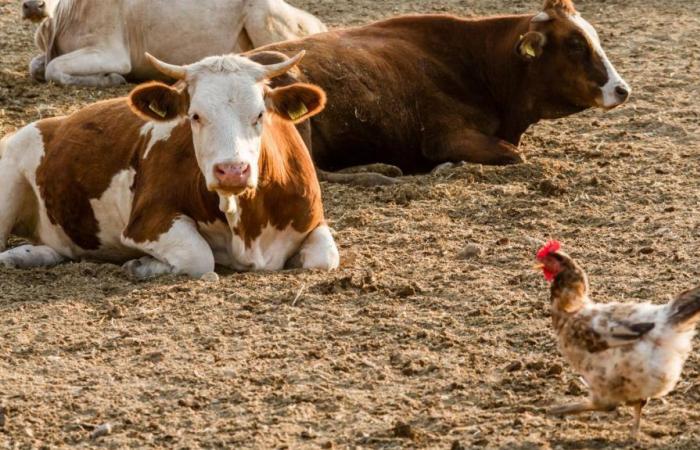The corona pandemic was not that long ago, and the next wave of infections is already looming: bird flu is rampant again – and is currently causing great concern in the USA. The H5N1 virus type has been spreading since the end of March, affecting dozens of farms. High viral loads were detected in some milk samples. The cows were probably infected by wild birds, according to the US Department of Agriculture at the time.
More and more cows in the USA are infected with the H5N1 virus.
Symbolfoto: IMAGO/Funke Foto Services
Close X characters Small sign symbolizing an X
In this context, bird flu has also been detected in several people – however, a person-to-person infection has not yet occurred.
Virologist Drosten fears bird flu as a new pandemic
Now, however, experts fear that the virus could evolve, so that human-to-human transmission could become conceivable in the future. Virologist Christian Drosten believes that, in the worst case scenario, bird flu could develop into a new pandemic:
“There has never been anything like this before, such extremely large outbreaks in cows – all experts are worried.”
Christian Drosten
virologist
The spread of bird flu among mammals could also be “mild, the virus needs several steps to adapt, and perhaps it will already be under control before then,” Drosten continued. “But it could also be the start of the next pandemic, which we are following live here.”
Bird flu is associated with a relatively high mortality rate. According to the Helmholtz Center Munich, younger people are particularly badly affected. The main symptoms are high fever, cough, shortness of breath and sore throat, sometimes also diarrhea and vomiting.
Previously 50,000 minks in Spain infected with bird flu
There have been cases of infected people over the years. According to the Robert Koch Institute, the sick people had close contact with the infected animals. A large amount of virus is probably needed for transmission, and infection is very rare.
In October 2022, for example, there was a case in Spain that is still keeping researchers busy: 50,000 minks had to be killed because they had become infected with bird flu. Although there had been isolated cases of infected mammals before, this scale was new. At the time, the researchers described it as an “unusual mutation” that could have “public health implications.”
Read more: World’s first death from bird flu virus type H5N2: What is the danger?
Tom Peacock, a virologist at Imperial College in London, told Science magazine that the case in Spain was “incredibly worrying”. For him, this was “a clear mechanism for how an H5 pandemic could start”.
Variant circulating in Germany can also infect cows
Now there is concern that transmission in cows is also increasing. The variant of the bird flu virus H5N1 circulating in Germany can also infect cows. This was recently shown by an initial test at the Friedrich Loeffler Institute (FLI) on the island of Riems near Greifswald.
The animals were infected via their teats with the pathogen, which came from a wild bird, the Federal Research Institute for Animal Health announced on Friday. The virus had multiplied in the udder and the dairy cows had shown clear symptoms of illness such as a sharp drop in milk production, changes in milk consistency and fever.
Currently, the risk to humans is still low
There are still genetic hurdles that prevent a so-called zoonosis, i.e. transmission from animals to humans, in the vast majority of cases: “So far, no pathogen has induced a pandemic through highly pathogenic forms of avian influenza caused by the virus subtypes H5 and H7. It is therefore unclear under what circumstances this would be possible and whether it is even possible for these subtypes,” explains Elke Reinking, spokeswoman for the Friedrich Loeffler Institute, which is the central government institution responsible for animal health in Germany.
However, as the cases of mink and now cows show, the bird flu virus also adapts to other life forms. However, this would probably not necessarily mean unhindered spread: “In flu viruses, hemagglutinin is particularly important for recognition by the immune system,” explains a spokeswoman for the Robert Koch Institute when asked by MDR.
Hemaglutinin is a membrane protein and is responsible for binding a virus to the host, in this case to humans. Since flu viruses belong to the same hemaglutinin group, there is a certain degree of cross-immunity between the different strains. However, it is impossible to say in advance how exactly humans will react to an adapted form of bird flu.
The World Health Organization (WHO) also considers the risk to humans posed by bird flu in cows to be low at present, but has warned all countries to pay increased attention to possible infections.







